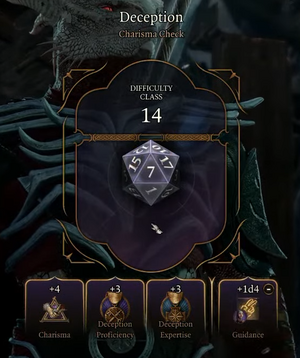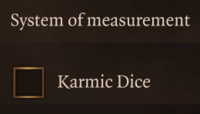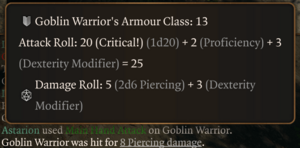More actions
Attacking a creature, making a shove attempt, spotting a hidden secret, and picking a lock are all examples of die rolls, which are the main method used to determine character success or failure in BG3. The amount of damage a character deals in combat is also determined by rolling dice.
In most circumstances, when a character makes a die roll, their Ability Score Modifier and Proficiency Bonus are added to the roll to determine the final result. The most common exception to this is the Damage Roll, which doesn't add a character's proficiency bonus unless explicitly stated.
The various types of dice used in rolls are referred to by the number of sides they have: ![]() D4,
D4, ![]() D6,
D6, ![]() D8,
D8, ![]() D10,
D10, ![]() D12, and
D12, and ![]() d20. Abbreviations are used to refer to the total number of dice used in a roll, such as 1d6 for rolling one D6 die, 2d4 for rolling two D4 dice, 8d6 for rolling eight D6 dice, and so on.
d20. Abbreviations are used to refer to the total number of dice used in a roll, such as 1d6 for rolling one D6 die, 2d4 for rolling two D4 dice, 8d6 for rolling eight D6 dice, and so on.
Some rolls need to reach a certain value to be considered a success. This is usually done with a ![]() d20, and the target value is called the Difficulty Class of the roll. Rolling a 1 on a D20 is referred to as a Natural 1 and rolling a 20 is referred to as a Natural 20. On some rolls, these can have special effects, such as automatically failing or succeeding the roll, ignoring Modifiers and Difficulty Class.
d20, and the target value is called the Difficulty Class of the roll. Rolling a 1 on a D20 is referred to as a Natural 1 and rolling a 20 is referred to as a Natural 20. On some rolls, these can have special effects, such as automatically failing or succeeding the roll, ignoring Modifiers and Difficulty Class.
Karmic Dice
When the Karmic Dice option is enabled (the default), the game will avoid frustrating streaks of very low rolls in a row.
However, Karmic Dice influence all rolls – including those of enemies – and the results will only ever skew toward a positive result for the dice roller. In short, the Karmic Dice setting makes combat encounters quicker and deadlier for both you and your enemies.
The exact algorithm for Karmic Dice is not presently known and may be changed between versions of the game.
Karmic Dice was previously referred to as 'Loaded Dice'.
Types of Rolls
Beyond the general principles explained above, the details of rolls depend on the type of roll that is being made. Following are the types of rolls in the game.
Attack Roll
Main page: Attack Roll
When a creature attacks another, the game rolls a D20. The result is modified by the attacking creature's Ability Score Modifier and Proficiency Bonus. If the result matches or exceeds the Armour Class of the target, then the attack is successful. Otherwise, it's a failure; this could mean the attack was a miss, failed to hurt the target due to its armour, or the target was able to dodge or parry.
Attacks done with Weapons always use an Attack Roll to determine success. Some spells also use an Attack Roll to determine whether they hit their intended target (such as ![]() Fire Bolt or
Fire Bolt or ![]() Eldritch Blast), though other spells hit the target automatically (such as
Eldritch Blast), though other spells hit the target automatically (such as ![]() Magic Missile or
Magic Missile or ![]() Fireball). A spell that hits its target automatically may allow the target to make a Saving Throw instead; see below.
Fireball). A spell that hits its target automatically may allow the target to make a Saving Throw instead; see below.
The Attack Roll should not be confused with the Damage Roll, which instead determines the amount of damage done to a target by a successful attack.
Critical Miss / Critical Hit
As a special case, a roll of 1 means that the attack fails regardless of bonuses or the target's Armour Class. This is called a Critical Miss.
Likewise, a roll of 20 means the attack succeeds regardless of the target's Armour Class. This is called a Critical Hit. A critical hit also affects the result of the Damage Roll. Currently, a critical hit doubles all damage dice involved in the damage roll (including additional dice such as those from Smites or Combat Maneuvers), but not the bonuses from modifiers or other flat damage bonuses such as ![]() Great Weapon Master: All In.
Great Weapon Master: All In.
Attack Roll Modifiers
The Ability Score used for the Ability Score Modifier depends on the type of attack that's being made. Melee and ranged weapon attacks use Strength or Dexterity, depending on the weapon. For spells, the Ability Score used for the Modifier generally depends on the class of the caster; see the main Attack Roll page for details.
For the creature's Proficiency Bonus to be added to the roll, the creature must be proficient in the kind of attack it's making. For weapon attacks, this is based on whether the creature has proficiency in the weapon being used. For spells, it's based on whether the creature has any innate spell casting capability granted by its class, subclass, or Feats.
Attack Rolls can also have ![]() Advantage /
Advantage / ![]() Disadvantage.
Disadvantage.
Damage Roll
Main page: Damage Roll
A Damage Roll is performed when a successful attack is made, a spell hits a target, a trap is activated, and so on. The result determines the damage done, in terms of hit-points. This roll can involve any type and number of dice.
For example, a successful hit with a Dagger will lead to a D4 being rolled to determine the damage (referred to as 1d4 damage), whereas a successful attack with a Greatsword will lead to two D6 being rolled (referred to as 2d6) for a total damage of 2 to 12. Being caught in a ![]() Fireball will cause 8d6 points of damage, though a successful Saving Throw (see below) can reduce it to half.
Fireball will cause 8d6 points of damage, though a successful Saving Throw (see below) can reduce it to half.
Damage Roll Modifiers
For attacks made with weapons, the total value resulting from the roll is affected by the attacking creature's Ability Score Modifier. For the damage of spell attacks, no such modifier applies, except when explicitly granted by a magical item or class feature, such as the Warlock's ![]() Agonising Blast invocation.
Agonising Blast invocation.
Saving Throw
Main page: Saving Throw
Various types of danger can be avoided, or their harm reduced, by making a ![]() Saving throw, also called a save. This could mean trying to avoid damage from a trap that was just activated, trying to resist the poison of a venomous bite, or trying to take cover to reduce damage from an explosion.
Saving throw, also called a save. This could mean trying to avoid damage from a trap that was just activated, trying to resist the poison of a venomous bite, or trying to take cover to reduce damage from an explosion.
The creature rolls a D20, and adds its Ability Score Modifier and Proficiency Bonus (if Proficient in that type of saving throw). The result must reach or exceed the Difficulty Class of the Saving Throw.
Saving Throw Modifiers
Which Ability Score is used for the Modifier depends on the source of danger against which the save is being made. For example, evading a spike trap may require Dexterity, whereas trying to resist the effects of a poisonous gas would require Constitution.
Depending on the Ability Score, the Saving Throw may be referred to as a Strength Saving Throw, Dexterity Saving Throw, Constitution Saving Throw, and so on. (Further shortened to Strength Save, Dexterity Save, etc.) The Proficiency Bonus is only added if the creature has Proficiency in the corresponding type of Saving Throw. Each Class grants a creature two Saving Throw Proficiencies.
Difficulty Class
Difficulty Class (or DC) is a number that must be matched or exceeded to achieve success when rolling for Ability Checks or Saving Throws. The Difficulty Class (DC) is determined by the source of danger:
- In scenarios such as traps or conversation events, the game chooses an appropriate Difficulty Class, depending on how serious the danger is.
- For the Difficulty Class of a Spell that imposes a Saving Throw, the DC is determined by the creature's Spellcasting Ability Modifier, using the following formula:
- For the Difficulty Class of a Weapon Action that imposes a Saving Throw, the DC is determined by the creature's Dexterity or Strength - whichever is higher - and a Weapon Ability's inherent DC Bonus, using the following formula:
Effect of Success
A successful save could mean completely avoiding negative effects, or it could mean reducing the damage received. For example, successfully saving against a spike trap could mean that a creature takes no damage at all, because it successfully evaded the spikes. On the other hand, if it's caught in the area of effect of a ![]() Fireball, then a successful save will merely halve the damage. Some effects don't allow for a Saving Throw at all, for example the damage taken from
Fireball, then a successful save will merely halve the damage. Some effects don't allow for a Saving Throw at all, for example the damage taken from ![]() Magic Missile.
Magic Missile.
Ability Check
Main page: Ability Check
Various actions, other than attacking or making a save, still require the creature to make an attempt that may fail. The creature rolls a D20, and adds its Ability Score Modifier and possibly its Proficiency Bonus. The attempted action has a specific Difficulty Class which the result of the roll must match or exceed.
Ability Checks can be based purely on an Ability Score, in which case they can only benefit from the Ability Score Modifier, but not the Proficiency Bonus.
Skill Check
More commonly, the check will be related to a specific Skill, which not only determines the Ability Score used for the Modifier, but also lets the creature use its Proficiency Bonus if it happens to be Proficient in that particular Skill. In this case, the check may be called a Skill Check rather than an Ability Check.
For example, when a trap is near a creature, and it's not yet activated, the game rolls a Perception Skill Check (or in short, "rolls Perception") to determine whether the creature notices the trap. Perception is related to Wisdom, so a creature with high Wisdom will gain a bonus. If the creature doesn't gain any bonus from Wisdom, it could still gain a bonus from being Proficient in the Perception Skill. If the creature both has high Wisdom and is proficient in Perception, it gains both bonuses.
Once the trap is seen, the creature may want to disarm it. This will require a Sleight of Hand Check, which is related to Dexterity. So, a creature that both has high Dexterity, and Proficiency in Sleight of Hand, can benefit from both types of bonuses when attempting to disarm the trap.
Contest
A Contest is a special type of Ability Check in which two creatures both roll an Ability Check or Skill Check to oppose each other, and one wins over the other. The creatures don't necessarily roll the same type of check.
An example of this is the File:Bonus Action Shove Icon.png Shove action, where the creature attempting the Shove must roll Athletics, and the defending creature is allowed to roll either Athletics or Acrobatics to contest the Shove. If the attacker's roll is higher than the defender's, the Shove succeeds, otherwise it fails.
Modifiers
Rolls can be modified by various bonuses and penalties. These can take the form of adding or subtracting a value from the result, or requiring two rolls instead of one and taking the lower or higher of the two values.
Advantage / Disadvantage
Main page: Advantage
In various situations, a creature can have ![]() Advantage or
Advantage or ![]() Disadvantage on an Attack Roll, Saving Throw, or Ability Check.
Disadvantage on an Attack Roll, Saving Throw, or Ability Check.
Advantage means that you make the roll twice and use the higher result. Disadvantage means you use the lower result.
Advantage and Disadvantage cannot stack. In other words, you never roll more than twice. Additionally, they cancel each other out, no matter how many sources of Advantage or Disadvantage you have. For instance, if you had three sources of Advantage and only one source of Disadvantage, they would still cancel each other out, causing you to roll normally.
Ability Score Modifier
Main page: Ability Score Modifier
A creature's Ability Scores can modify the result of rolls, depending on how high or low the Ability Score is. Which Ability Score is used to determine the Modifier depends on the roll that's being made. The Ability Score Modifier for a specific Ability Score can also be referred to by the name of that Ability Score, such as: Strength Modifier, Dexterity Modifier, etc.
For Attack Rolls
Weapon attacks will generally use Strength or Dexterity, depending on the weapon and the type of attack made. See Attack Roll for details.
Spell attacks will use an Ability Score depending on the Class of the creature making it. Again, see the Attack Roll page for details.
For Damage Rolls
For Weapon attacks, the same rules apply to Damage Rolls as for Attack Rolls. If the Damage Roll involves multiple dice, such as the 2d6 damage of a Greatsword, then the Modifier is applied to the total value, not to each individual die.
For the damage of Spells, there is generally no Ability Score Modifier, though there are exceptions to this rule. For example, ![]() Agonising Blast allows the Warlock to add its Charisma Modifier to the damage of
Agonising Blast allows the Warlock to add its Charisma Modifier to the damage of ![]() Eldritch Blast.
Eldritch Blast.
For Saving Throws
For saves against various threats, the threat in question determines which Ability Score is used to make the save. For example, the ![]() Web spell requires you to make a Dexterity Save, whereas
Web spell requires you to make a Dexterity Save, whereas ![]() Crown of Madness requires a Wisdom Save.
Crown of Madness requires a Wisdom Save.
For Difficulty Class
An Ability Score Modifier is also used in the Difficulty Class of a Saving Throw, such as by casting a spell. The Modifier affects the Difficulty Class (DC) of the Save imposed on the target, using the formula:
This allows spellcasters to increase the effectiveness of their spells by increasing their Spellcasting Ability Modifier, even when those spells do not involve Attack Rolls.
Note: The Ability Score used to determine the Spell Save DC is not necessarily the same as the type of Saving Throw imposed on targets.
For Ability Checks
An Ability Check is always based on a specific Ability Score, which determines the Ability Score Modifier that will be used. One type of Ability Check is the Skill Check, since each Skill is based on a specific Ability Score. For example, an Athletics Check uses Strength, whereas a Sleight of Hand Check uses Dexterity.
Proficiency Bonus
Main page: Proficiency Bonus
Creatures can have Proficiency in a number of different areas, allowing them to add their ![]() Proficiency Bonus to related rolls. Proficiencies can be granted by a creature's Background, Race, Class, and Feats chosen when leveling up.
Proficiency Bonus to related rolls. Proficiencies can be granted by a creature's Background, Race, Class, and Feats chosen when leveling up.
For Attack Rolls
Attack Rolls made with Weapons can benefit from Proficiency with the type of weapon that's being used. This kind of Proficiency can be granted by the creature's Race, Class, or Feats chosen when leveling up.
Attack Rolls made for spells benefit from Proficiency in spell casting, which all creatures capable of casting spells have. The creature could have spell casting capabilities due to its Class, or from a Feat it chose when leveling up.
For Saving Throws
A creature can have Proficiency in a specific type of Saving Throw, like Strength Saving Throws or Dexterity Saving Throws. Each Class gains Proficiency in two such types of Saving Throw at level 1, and it can add their Proficiency Bonus to those types of Saving Throws.
For Difficulty Class
A creature's Proficiency Bonus also affects the Difficulty Class of the Saving Throw that enemies must roll when affected by that creature's spells (and some non-spell abilities). The formula for this is:
For Ability Checks
An Ability Check may be based only on an Ability rather than a Skill, in which case no Proficiency Bonus is possible. If it's based on a Skill, however, a creature will get a Proficiency Bonus in the corresponding Skill Checks if it's Proficient in that Skill.
Proficiency in a Skill can be granted by Race, Class, or a Feat chosen when leveling up. For example, all Elves have an innate feature called Keen Senses which grants them Proficiency in Perception. Rangers can gain Proficiency in a number of skills based on class features they choose: Bounty Hunter grants Proficiency in Investigation, Keeper of the Veil and Mage Breaker both grant Proficiency in Arcana, and so on. The Skilled Feat, if chosen when leveling up, allows a creature to gain Proficiency in any three Skills.



